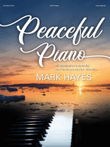Details
-
- Instrument:
- Piano Solo
-
- Format:
- Collection / Songbook
- Item types:
- Physical
- Level:
- Late Intermediate
- Usages:
- School and Community
SKU: KJ.WP563
Composed by Bonnie von Reis Doe. Piano. Collection. Neil A. Kjos Music Company #WP563. Published by Neil A. Kjos Music Company (KJ.WP563).ISBN 9780849796975. 9 x 12 inches.
This collection of pieces reflects my fascination with harmonies, chord qualities and progressions, and how a simple change can profoundly alter the emotional effect of a motif or theme. It is hardly a new concept that the 88 keys of the piano are analogous to an artist's palette, and that both offer virtually limitless combinations of color. Some composers have even expressed this idea by choosing specific colors for certain notes or keys. It is this concept that prompted me to try to "paint" a portrait of each of my grandchildren with music. Each piece reflects the principal personality traits of one of my grandchildren. What surprised me most was how easily all the pieces came together; they seemed to write themselves! In general, these pieces were composed with young people in mind. There are some technical challenges, but all are stepping stones to more advanced works. The challenges are short in length and can be very rewarding when mastered. Many of the motifs are only a measure long and can be played with lots of rubato, allowing the performer a feeling of freedom and self-expression. All the pieces leave plenty of room for interpretation, so that each performer can make them his or her own. Today's composers have an incredible wealth of ideas at their disposal. In this collection you will hear a variety of elements drawn from all periods of music. Many of my harmonies and melodies are derived from the intervalic relationships and tone colors of the medieval modes. Fantasia utilizes segments of a Hungarian mode, as well as fragments of symmetrical scales that are popular in the jazz idiom. Oriental pentatonic clusters are found in measure 18, and the ending consists of an arpeggio of ascending fifths—a more modern touch. All of these features give the piece an exotic and mysterious tonality. My harmonic language has also been influenced by 20th century composers such as Sergei Prokofieff, Arnold Schoenberg, Igor Stravinski and Vincent Persichetti. Quartal harmony, so prevalent in the music of these composers and in jazz, can be heard in Impromptu. I especially like the way jazz great Bill Evans used harmony. His influence, for example, is evident in the secundal harmonies found in Waltz and Fantasia. In Toccata the jazz rhythms of the introduction and ending create a "classical jazz" feeling, which is one of my favorite styles of music. As a teacher, I'm always aware of lessons that can be taught through performance music. The simple folk-like melody heard in Ländler progresses through 11 minor keys. This offers a great basic theory lesson. The student can bracket and name each modulation and learn from this example how scale and arpeggio training is directly applicable to the music he or she plays.
SKU: KJ.WP563
Composed by Bonnie von Reis Doe. Piano. Collection. Neil A. Kjos Music Company #WP563. Published by Neil A. Kjos Music Company (KJ.WP563).ISBN 9780849796975. 9 x 12 inches.
This collection of pieces reflects my fascination with harmonies, chord qualities and progressions, and how a simple change can profoundly alter the emotional effect of a motif or theme. It is hardly a new concept that the 88 keys of the piano are analogous to an artist's palette, and that both offer virtually limitless combinations of color. Some composers have even expressed this idea by choosing specific colors for certain notes or keys. It is this concept that prompted me to try to "paint" a portrait of each of my grandchildren with music. Each piece reflects the principal personality traits of one of my grandchildren. What surprised me most was how easily all the pieces came together; they seemed to write themselves! In general, these pieces were composed with young people in mind. There are some technical challenges, but all are stepping stones to more advanced works. The challenges are short in length and can be very rewarding when mastered. Many of the motifs are only a measure long and can be played with lots of rubato, allowing the performer a feeling of freedom and self-expression. All the pieces leave plenty of room for interpretation, so that each performer can make them his or her own. Today's composers have an incredible wealth of ideas at their disposal. In this collection you will hear a variety of elements drawn from all periods of music. Many of my harmonies and melodies are derived from the intervalic relationships and tone colors of the medieval modes. Fantasia utilizes segments of a Hungarian mode, as well as fragments of symmetrical scales that are popular in the jazz idiom. Oriental pentatonic clusters are found in measure 18, and the ending consists of an arpeggio of ascending fifths—a more modern touch. All of these features give the piece an exotic and mysterious tonality. My harmonic language has also been influenced by 20th century composers such as Sergei Prokofieff, Arnold Schoenberg, Igor Stravinski and Vincent Persichetti. Quartal harmony, so prevalent in the music of these composers and in jazz, can be heard in Impromptu. I especially like the way jazz great Bill Evans used harmony. His influence, for example, is evident in the secundal harmonies found in Waltz and Fantasia. In Toccata the jazz rhythms of the introduction and ending create a "classical jazz" feeling, which is one of my favorite styles of music. As a teacher, I'm always aware of lessons that can be taught through performance music. The simple folk-like melody heard in Ländler progresses through 11 minor keys. This offers a great basic theory lesson. The student can bracket and name each modulation and learn from this example how scale and arpeggio training is directly applicable to the music he or she plays.
Preview: Portraits For Piano
Ratings + Reviews
- Explain exactly why you liked or disliked the product. Do you like the artist? Is the transcription accurate? Is it a good teaching tool?
- Consider writing about your experience and musical tastes. Are you a beginner who started playing last month? Do you usually like this style of music?
- Feel free to recommend similar pieces if you liked this piece, or alternatives if you didn't.
- Be respectful of artists, readers, and your fellow reviewers. Please do not use inappropriate language, including profanity, vulgarity, or obscenity.
- Avoid disclosing contact information (email addresses, phone numbers, etc.), or including URLs, time-sensitive material or alternative ordering information.
- We cannot post your review if it violates these guidelines. If you have any suggestions or comments on the guidelines, please email us.
- All submitted reviews become the licensed property of Sheet Music Plus and are subject to all laws pertaining thereto. If you believe that any review contained on our site infringes upon your copyright, please email us.
- Read Sheet Music Plus's complete Privacy Policy
Tell A Friend
Tell a friend (or remind yourself) about this product. We'll instantly send an email containing product info and a link to it. You may also enter a personal message.
We do not use or store email addresses from this form for any other purpose than sending your share email.
Read our Privacy Policy.
Learn about MP3s
Learn about Smart Music
Learn about Digital Video
You may also like
-
$6.50
-
$6.50
-
$6.50
-
$6.50
-
$6.50
-
$3.95
-
$6.50
-
$6.50
-
$6.50
-
$6.50
-
$3.45
-
$6.50
-
$4.45
-
$6.50
-
$6.50
-
$6.50
-
$6.50
-
$5.99
-
$2.45
-
$5.99
Recommended Products Based on Portraits For Piano
-
$6.50
-
$6.50
-
$6.50
-
$6.50
-
$6.50
-
$3.95
-
$6.50
-
$6.50
-
$6.50
-
$6.50
-
$3.45
-
$6.50
-
$4.45
-
$6.50
-
$6.50
-
$6.50
-
$6.50
-
$2.45
-
$6.50
-
$6.50
Top-selling in Piano Solo
-
$69.95
-
$32.95
-
$5.99
-
$23.25
-
$26.95
-
$7.99
-
$23.25
-
$22.95
-
$34.99
-
$17.95
-
$355.95
-
$21.99
-
$126.00
-
$61.95
-
$26.95
-
$5.99
-
$32.95
-
$12.99










































